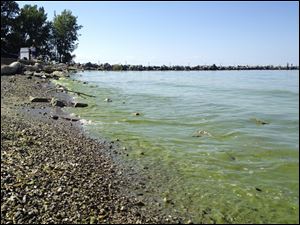
Science will save Lake Erie
6/7/2018
Shamrock-green waves imbued with algae lap against the Lake Erie shoreline near downtown Port Clinton.
Rescuing Lake Erie from toxic-algae-producing pollution is going to demand a lot of political willpower and no small amount of science.
It is going to take science to quantify exactly how much algae-feeding phosphorus is pouring into the lake from the Maumee River and other waterways. It is going to take science to identify exactly where that phosphorus is coming from. And it is going to take science to measure how much we need to reduce that pollution to clean up the lake.
Click here to view more Blade editorials
Beyond that, science is going to have to play key roles in figuring out the best strategies to help farmers grow their crops and manage their livestock without polluting waterways with agricultural runoff. Science is going to help determine the best ways to use cover crops and alternative fertilizing techniques.
Science, too, is going to be necessary to figure out what to do about another — albeit smaller — source of phosphorus in the open lake: dredged silt.
For years, the U.S. Army Corps of Engineers has dumped the material it dredges from the Toledo shipping lanes into the open lake. Scientists believe that practice recirculates algae-bloom-fueling material that had sunk to the bottom.
Even before the 2014 water crisis that rendered Toledo’s drinking water unusable for three days, scientists were investigating what else could be done with the dredging material to keep it out of the open lake.
The Great Lakes Dredged Material Center for Innovation — a 10-acre site in North Toledo developed to investigate potential agricultural uses for silt removed from Toledo’s shipping channel — is accepting research proposals through Aug. 3. Awards are expected to be made in September, with planting on site a year from now.
Now, faced with a 2020 deadline to end the practice of open-lake disposal, the corps needs those options. It plans to apply the material to a pair of farms in Oregon with hopes of expanding to include more farms.
It will not be enough to tell the Army Corps of Engineers it cannot dump silt into the lake. We have to investigate alternatives. And it will not be enough to tell Ohio’s farmers to end the practices that lead to agricultural runoff. We will need to offer alternatives.
As with the dredged-material innovation center in Toledo, it will be imperative for Ohio to invest in the science and innovation that offers alternatives we need to save Lake Erie.